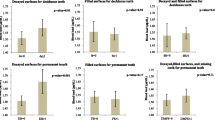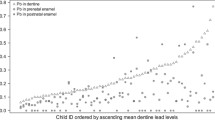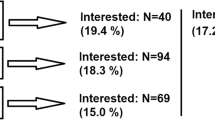Abstract
Lead and cadmium levels in blood and deciduous teeth (shed incisors only) of 6-year-old German children were determined in 1991 in a large epidemiological study carried out in rural and urban areas of western Germany (Duisburg, Essen, Gelsenkirchen, Dortmund, Borken) and eastern Germany (Leipzig, Halle, Magdeburg, Osterburg, Gardelegen, Salzwedel). In total, blood lead and cadmium levels of 2311 German children and tooth lead and cadmium levels of 790 German children were analyzed. Blood lead levels were generally low in all study areas with geometric means between 39.3 μg/1 and 50.8 μg/l in the western German and between 42.3 μg/1 and 68.1 μg/l in the eastern German study areas. The mean blood lead level of Turkish children (n = 213) living in the western German study areas was 50.1 μg/l and thus 5.6 μg/1 higher than the overall geometric mean of the western German children. The higher exposure may be explained by a higher oral uptake from food and different living conditions. These children were excluded from multiple regression analysis because they were all living in the western study areas. The mean tooth lead levels ranged between 1.50 and 1.74 μg/g in the western and between 1.51 μg/g and 2.72 μg/g in the eastern study areas. Thus, they show a distribution pattern similar to blood. Blood and tooth lead levels were higher in urban than in rural areas and higher in the eastern German than in the western German study areas. With regard to the blood and tooth cadmium concentrations, no significant differences between the study areas could be found. The mean cadmium levels in blood ranged between 0.12 μg/1 and 0.14 μg/l and the mean tooth cadmium concentrations between 20.8 ng/g and 27.8 ng/g. Blood and tooth lead and cadmium levels of the eastern and western German children were thus mainly at a relatively low level in all rural and urban study areas. The study demonstrates and confirms that blood and tooth lead levels are influenced by several demographic, social, and environmental variables. The results indicate that there has been a further significant decrease of lead and cadmium exposure in western German children since our last epidemiological study carried out in the same study areas in 1985/1986.
Similar content being viewed by others
References
Bellinger D, Sloman J, Levinton A, Rabinowitz M, Needleman H, Waternaux C (1991) Low-level exposure and children's cognitive function in the preschool years. Pediatrics 87:219–227
Bjerre B, Berglund M, Harsbo K, Hellman B (1993) Blood lead concentrations of Swedish preschool children in a community with high lead levels from mine waste in soil and dust. Scand J Work Environ Health 19:154–161
Brockhaus A, Freier I, Ewers U, Jermann E, Dolgner R (1983) Levels of cadmium and lead in blood in relation to smoking, sex, occupation and other factors in an adult population of the FRG. Int Arch Occup Environ Health 52:167–175
Brockhaus A, Collet W, Dolgner R, Engelke R, Ewers U, Freier I, Jermann E, Krämer U, Manojlovic N, Turfeld M, Winneke G (1988) Exposure to lead and cadmium of children living in different areas of North-West Germany: results of biological monitoring studies 1982–1986. Int Arch Occup Environ Health 60:211–222
Cardia P, Pau M, Ibba A, Flore C, Cherchi P, Casula D (1989) Blood lead levels in children of S. W. Sardinia. Eur J Epidemiol 5:378–381
Dietrich HN, Succop PA, Berger O, Hammond P, Bornschein RL (1991) Lead exposure and cognitive development of urban preschool children: the Cincinnati lead study cohort at the age 4 years. Neurotoxicol Teratol 13:203–211
Ducroffe G, Claeys F, Bruaux P (1990) Lowering time trend of blood lead levels in Belgium since 1978. Environ Res 51:25–34
Elinder CG, Friberg L, Lind B, Jawaid M (1983) Lead and cadmium levels in blood samples from the general population of Sweden. Environ Res 30:233–253
Elinder CG, Friberg L, Lind B, Nilsson B, Svartengren M, Övermark I (1986) Decreased blood lead in residents of Stockholm for the period 1980–1984. Scand J Work Environ Health 12:112–120
Ewers U, Turfeld M, Freier I, Ferger S, Brockhaus A (1990) Blei- und Cadmiumgehalte in Milchzähnen von Kindern aus Duisburg und Gummersbach — Entwicklungstrend 1976–1988. Zbl Hyg 189:333–351
Fergusson DM, Fergusson JE, Horwood LJ, Kinzett NG (1988) A longitudinal study of dentine lead levels, intelligence, school performance, and behavior. Part II: dentine lead and cognitive ability. J Child Psych Psychiat 29:793–809
Fosse G, Berg-Justesen NP (1977) Cadmium in deciduous teeth of Norwegian children. Int J Environ Stud 11:17–27
Fulton M, Raab G, Thompson G, Laxen D, Hunter R, Hepburn W (1987) Influence of blood lead on the ability and attainment of children in Edinburgh. Lancet 1:1221–1226
Grandjean P, Lyngbye T, Hansen ON (1991) Lessons from a Danish study on neuropsychological impairment related to lead exposure. Environ Health Perspect 94:111–115
Krämer U, Altmann L, Begerow J, Bredel H, Freier I, Winneke G (1994) Die Bleibelastung von Kindern aus Ost- und Westdeutschland — Expositionsquellen und Auswirkungen auf das Zentralnervensystem. Inform Biometr Epidemiol Med Biol 25:58–73
Lyngbye T, Hansen ON, Trillingsgaard A, Beese I, Grandjean P (1990) Learning disabilities in children: significance of lowlevel head exposure and confounding effects. Acta Pediatr Scand 79:352–360
McMichael AJ, Baghurst PA, Wyg NR, Vimpani GV, Robertson EF, Roberts RJ (1988) Port Pirie cohort study: environmental exposure to lead and children's abilities at four years. N Engl J Med 329:468–475
Needleman HL (1989) The persistent threat of lead: a singular opportunity. Am J Publ Health 79:643–645
Pönkä A, Salminen E, Ahonen S (1992) Lead in ambient air and blood specimens of children in Helsinki. Sci Total Environ 138:301–308
Roels HA, Buchet JP, Lauwerys RR, Bruaux P, Claeys-Thoreau F, Lafontaine A, Verduyn G (1980) Exposure to lead by the oral and the pulmonary routes of children living in the vicinity of a primary lead smelter. Environ Res 22:81–94
Stoeppler M, Brandt K, Rains T (1978) Rapid method for the automated determination of lead in whole blood by electrothermal atomic absorption spectrometry. Analyst 103:714–722
Thomson GOB, Raab GM, Hepburn WS, Hunter R, Fulton M, Laxen DPH (1989) Blood-lead levels and children's behaviour — results from the Edinburgh lead study. J Child Psychol Psychiat 30:515–528
Winneke G, Brockhaus A, Ewers U, Krämer U, Neuf M (1990) Results from the European multicenter study on lead neurotoxicity in children: implications for risk assessment. Neurotoxicol Teratol 12:553–559
Author information
Authors and Affiliations
Rights and permissions
About this article
Cite this article
Begerow, J., Freier, I., Turfeld, M. et al. Internal lead and cadmium exposure in 6-year-old children from western and eastern Germany. Int. Arch Occup Environ Heath 66, 243–248 (1994). https://doi.org/10.1007/BF00454362
Received:
Accepted:
Issue Date:
DOI: https://doi.org/10.1007/BF00454362




